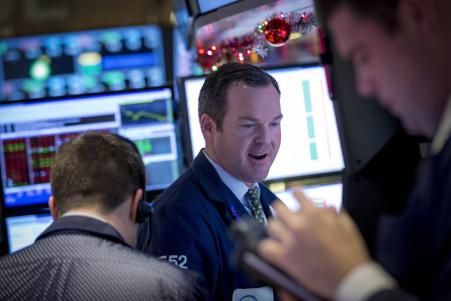By Jessica Menton -
Wall Street is looking ahead to a series of data points that could push the U.S. stock market into a “Santa Claus Rally,” following last week’s advances that saw the Dow Jones Industrial Average post its best one-day point gain since 2011. The blue-chip Dow continues edging closer to the psychologically important 18,000 milestone. Ahead on this week’s economic calendar, economists will be eyeing data that will reveal details about U.S. consumer spending and personal income ahead of the Christmas holiday.
Following Monday’s open, the Dow jumped 83.61 points, or 0.47 percent, at 17,888.41; the S&P 500 Index gained 0.91 points, or 0.04 percent, at 2,071.93. The Nasdaq Composite added 6.39 points, or 7.58 percent, to 4,773.69.
Friday, the S&P 500 Index soared within a mere five points of its all-time closing record and recorded its biggest weekly gain in nearly two years. Meanwhile, the Dow skyrocketed just over 420 points Thursday, hitting its best one-day point gain since Nov. 30, 2011. On Dec. 5, the blue-chip Dow came within just 10 points of hitting the psychologically important milestone of 18,000. On these indicators heading into the last few trading days of the year, analysts expect the U.S. stock market to continue the rally.
The “Santa Claus Rally” actually refers to the last five trading days of the year and the first two trading days of the New Year. “It’s an old adage that if Santa Claus doesn’t come, meaning the stock market doesn’t rally, then it sets the stage for a potentially bear market in the year to come, but I say we rally into the year-end,” Karl Snyder, chief market strategist at Garden State Securities, said.
Economists expect data on Tuesday to show the U.S. economy expanded at a 4.3 percent annual pace last quarter, instead of the previously reported 3.9 percent rate, in the Commerce Department’s final estimate of third-quarter gross domestic product, according to analysts polled by Thomson Reuters.
Gasoline prices dropped to the lowest since 2009, tumbling 24.68 cents in the two weeks ended Dec. 19 to $2.47 a gallon, according to a survey released Sunday by independent market research company Lundberg Survey Inc. Lower gas prices are expected to boost consumer spending this holiday shopping season as they have fallen more than $1.25 a gallon from peaking in May. “Clearly, consumers are benefitting from low energy prices. Low energy costs are bolstering sentiment and discretionary income, which bode well for overall sales during this holiday season,” Terry Sandven, chief equity strategist at U.S. Bank Wealth Management, said.
Following Black Friday and Thanksgiving Day sales last month, Wall Street anticipates data Tuesday will show consumer spending, which accounts for nearly two-thirds, or 75 percent, of the U.S. economy, to rise 0.5 percent last month after increasing 0.2 percent in October.
“Falling oil prices are overwhelmingly a positive for the global economy as a whole because what it effectively does is transfer income from oil producers who tend to save towards oil consumers that tend to spend, which should create growth,” Neil Shearing, chief emerging markets economist at Capital Economics, said.
As the Federal Reserve’s final meeting of the year came to a close last week, economists are looking to personal consumption expenditures data, or the preferred measure the central bank uses to measure U.S. inflation, to see if a strong figure could mean the Fed could hike interest rates sooner than anticipated next year. Inflation has continued to run below the Fed’s 2 percent target nearly 30 consecutive months after data last month showed the PCE Index rose 0.1 percent in October from September and increased 1.4 percent from a year earlier, the Commerce Department said Nov. 26.
Also on Tuesday, new home sales are expected to show an increase to a 460,000-unit pace in November from a previous 458,000-unit rate. The pace of new home sales climbed 0.7 percent in October to an annualized pace of 458,000 units.
Here's the latest economic calendar for the week of Dec. 22. All listed times are EST.
Monday, Dec. 22
10 a.m. -- Existing home sales (Nov.)
Non-U.S.:
Japan -- Bank of Japan releases Monthly Economic Survey
Tuesday, Dec. 23
8:30 a.m. – Final revision of U.S. gross domestic product (Q3)
8:30 a.m. -- Durable goods orders (Nov.)
9:55 a.m. -- Consumer sentiment (Dec.)
10 a.m. -- Personal income (Nov.)
10 a.m. – Consumer spending (Nov.)
10 a.m. – Personal Consumption Expenditures/Core inflation (Nov.)
10 a.m. -- New home sales (Nov.)
Non-U.S.:
Wednesday, Dec. 24
8:30 a.m. -- Weekly jobless claims
Non-U.S.:
Japan -- Bank of Japan releases monetary policy meeting minutes
Thursday, Dec. 25
Christmas Day – No major U.S. economic data scheduled.
Non-U.S.:
Japan -- National Consumer Price Index (Nov.)
Friday, Dec. 26
No major U.S. economic data scheduled.
Non-U.S.:
Canada -- Boxing Day
New Zealand -- Boxing Day
U.K. -- Boxing Day
Australia -- Boxing Day
Greece -- Boxing Day
Germany -- Boxing Day
Switzerland -- St. Stephen's Day
Italy -- St. Stephen's Day
